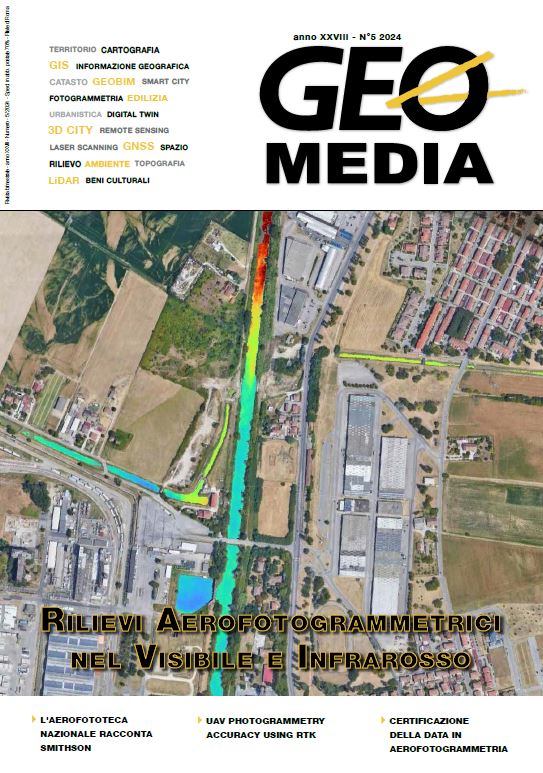VALUTAZIONE DELL'INFLUENZA DEL NUMERO DI GCP SULLA QUALITÀ DELLE MISURAZIONI DI UN BLOCCO FOTOGRAMMETRICO CATTURATO CON UN UAV RTK IN AMBIENTI GEOGRAFICI CON ALTA RUGOSITÀ TOPOGRAFICA
Parole chiave:
Georeferenziazione Diretta; GCPs; Blocco Fotogrammetrico; Valutazione dell'Accuratezza.Abstract
El uso de puntos de control terrestres (GCP) es fundamental para calibrar con precisión el posicionamiento fotogramétrico en detección remota con vehículos aéreos (UAV). Sin embargo, posicionar manualmente los GCP durante la georreferenciación puede resultar costoso y llevar mucho tiempo, especialmente en terrenos complejos, lo que potencialmente limita la eficiencia operativa y la eficacia del sistema. Sin embargo, la integración de receptores de navegación modernos con software avanzado de cine en tiempo real (RTK) ofrece un potencial significativo para mejorar la precisión fotogramétrica cuando se utiliza con vehículos aéreos no tripulados. El propósito de este estudio fue evaluar cómo los diferentes candidatos de GCP afectan la precisión fotogramétrica en terrenos geográficamente desafiantes. Si utiliza un vehículo aéreo no tripulado equipado con tecnología RTK avanzada respaldada por el Sistema de Navegación Global por Satélite (GNSS). El Error Cuadrático Medio (RMSE) de los Puntos de Control (CP) se utiliza para evaluar la calidad de los medicamentos en los escenarios propuestos. Los resultados indican que aumentar el número de GCP y garantizar una distribución uniforme reduce significativamente el RMSE para los CP, observándose mejoras a partir de 3 GCP, contrariamente a estudios anteriores que sugerían 1 GCP en el contexto de georreferenciación directa (DG). El análisis de los resultados sugiere un rango óptimo de 4 a 5 GCP, que proporciona resultados consistentemente en el rango de decímetros.
Riferimenti bibliografici
Benassi, F., Dall’Asta, E., Diotri, F., Forlani, G., Cella, U. M. di, Roncella, R., & Santise, M. (2017). Testing accuracy and repeatability of UAV blocks oriented with gnss-supported aerial triangulation. Remote Sensing, 9(2), 1–23. https://doi.org/10.3390/rs9020172
Bertin, S., Levy, B., Gee, T., & Delmas, P. (2020). Geomorphic change detection using cost-effective structure-from-motion photogrammetry: Evaluation of direct georeferencing from consumer-grade uas at orewa beach (new zealand). Photogrammetric Engineering and Remote Sensing, 86(5), 289–298. https://doi.org/10.14358/PERS.86.5.289
Bertin, S., Stéphan, P., & Ammann, J. (2022a). Assessment of RTK Quadcopter and Structure-from-Motion Photogrammetry for Fine-Scale Monitoring of Coastal Topographic Complexity. Remote Sensing, 14(7). https://doi.org/10.3390/rs14071679
Bertin, S., Stéphan, P., & Ammann, J. (2022b). Evaluación de cuadricóptero RTK y fotogrametría de estructura a partir del movimiento para el monitoreo a escala fina de la complejidad topográfica costera. Remote Sensing, 14(7). https://doi.org/10.3390/rs14071679
Cho, J. M., & Lee, B. K. (2023). GCP and PPK Utilization Plan to Deal with RTK Signal Interruption in RTK-UAV Photogrammetry. Drones, 7(4). https://doi.org/10.3390/drones7040265
Czy?a, S., Szuniewicz, K., Kowalczyk, K., Dumalski, A., Ogrodniczak, M., & Zieleniewicz, ?. (2023). Assessment of Accuracy in Unmanned Aerial Vehicle (UAV) Pose Estimation with the REAL-Time Kinematic (RTK) Method on the Example of DJI Matrice 300 RTK. Sensors, 23(4). https://doi.org/10.3390/s23042092
Elkhrachy, I. (2021). Accuracy Assessment of Low-Cost Unmanned Aerial Vehicle (UAV) Photogrammetry. Alexandria Engineering Journal, 60(6), 5579–5590. https://doi.org/10.1016/j.aej.2021.04.011
Kim, H., Hyun, C. U., Park, H. D., & Cha, J. (2023). Image Mapping Accuracy Evaluation Using UAV with Standalone, Differential (RTK), and PPP GNSS Positioning Techniques in an Abandoned Mine Site. Sensors, 23(13). https://doi.org/10.3390/s23135858
Liu, X., Lian, X., Yang, W., Wang, F., Han, Y., & Zhang, Y. (2022). Accuracy Assessment of a UAV Direct Georeferencing Method and Impact of the Configuration of Ground Control Points. Drones, 6(2). https://doi.org/10.3390/drones6020030
Oniga, V. E., Breaban, A. I., Pfeifer, N., & Chirila, C. (2020). Determining the suitable number of ground control points for UAS images georeferencing by varying number and spatial distribution. Remote Sensing, 12(5). https://doi.org/10.3390/rs12050876
Padró, J. C., Carabassa, V., Balagué, J., Brotons, L., Alcañiz, J. M., & Pons, X. (2019). Monitoring opencast mine restorations using Unmanned Aerial System (UAS) imagery. Science of the Total Environment, 657, 1602–1614. https://doi.org/10.1016/j.scitotenv.2018.12.156
Park, J. W., & Yeom, D. J. (2022). Method for establishing ground control points to realize UAV-based precision digital maps of earthwork sites. Journal of Asian Architecture and Building Engineering, 21(1), 110–119. https://doi.org/10.1080/13467581.2020.1869023
Pourreza, M., Moradi, F., Khosravi, M., Deljouei, A., & Vanderhoof, M. K. (2022). GCPs-Free Photogrammetry for Estimating Tree Height and Crown Diameter in Arizona Cypress Plantation Using UAV-Mounted GNSS RTK. Forests, 13(11). https://doi.org/10.3390/f13111905
Stott, E., Williams, R. D., & Hoey, T. B. (2020a). Distribución de puntos de control terrestre para mapeo topográfico preciso a escala de kilómetros utilizando un vehículo aéreo no tripulado RTK-GNSS y fotogrametría SfM. www.mdpi.com/journal/dronesTraducidodelinglésalespañol-www.onlinedoctranslator.com
Stott, E., Williams, R. D., & Hoey, T. B. (2020b). Ground control point distribution for accurate kilometre-scale topographic mapping using an rtk-gnss unmanned aerial vehicle and sfm photogrammetry. Drones, 4(3), 1–21. https://doi.org/10.3390/drones4030055
Štroner, M., Urban, R., Seidl, J., Reindl, T., & Brou?ek, J. (2021). Photogrammetry using UAV-mounted GNSS RTK: Georeferencing strategies without GCPs. Remote Sensing, 13(7). https://doi.org/10.3390/rs13071336
Taddia, Y., Stecchi, F., & Pellegrinelli, A. (2020). Coastal mapping using dji phantom 4 RTK in post-processing kinematic mode. Drones, 4(2), 1–19. https://doi.org/10.3390/drones4020009
Villanueva, J. K. S., & Blanco, A. C. (2019). Optimization of ground control point (GCP) configuration for unmanned aerial vehicle (UAV) survey using structure from motion (SFM). International Archives of the Photogrammetry, Remote Sensing and Spatial Information Sciences - ISPRS Archives, 42(4/W12), 167–174. https://doi.org/10.5194/isprs-archives-XLII-4-W12-167-2019
Yang, J., Li, X., Luo, L., Zhao, L., Wei, J., & Ma, T. (2022). New Supplementary Photography Methods after the Anomalous of Ground Control Points in UAV Structure-from-Motion Photogrammetry. Drones, 6(5). https://doi.org/10.3390/drones6050105
Zhang, K., Okazawa, H., Hayashi, K., Hayashi, T., Fiwa, L., & Maskey, S. (2022a). Optimization of Ground Control Point Distribution for Unmanned Aerial Vehicle Photogrammetry for Inaccessible Fields. Sustainability (Switzerland), 14(15). https://doi.org/10.3390/su14159505
Zhang, K., Okazawa, H., Hayashi, K., Hayashi, T., Fiwa, L., & Maskey, S. (2022b). Optimization of Ground Control Point Distribution for Unmanned Aerial Vehicle Photogrammetry for Inaccessible Fields. Sustainability (Switzerland), 14(15). https://doi.org/10.3390/su14159505
Pubblicato
Fascicolo
Sezione
Licenza

Questo volume è pubblicato con la licenza Creative Commons Attribuzione - Non commerciale - Condividi allo stesso modo 4.0 Internazionale.
Gli autori che pubblicano su questa rivista accettano le seguenti condizioni:- Gli autori mantengono i diritti sulla loro opera e cedono alla rivista il diritto di prima pubblicazione dell'opera, contemporaneamente licenziata sotto una Licenza Creative Commons - Attribuzione che permette ad altri di condividere l'opera indicando la paternità intellettuale e la prima pubblicazione su questa rivista.
- Gli autori possono aderire ad altri accordi di licenza non esclusiva per la distribuzione della versione dell'opera pubblicata (es. depositarla in un archivio istituzionale o pubblicarla in una monografia), a patto di indicare che la prima pubblicazione è avvenuta su questa rivista.
- Gli autori possono diffondere la loro opera online (es. in repository istituzionali o nel loro sito web) prima e durante il processo di submission, poiché può portare a scambi produttivi e aumentare le citazioni dell'opera pubblicata (Vedi The Effect of Open Access).





